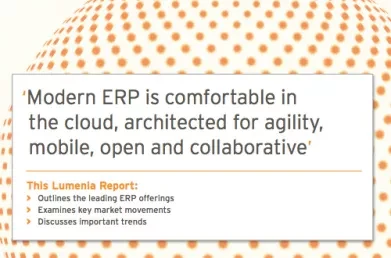Reflections on Microsoft Convergence 2013 – 10 Takeouts
Recently we attended Convergence 2013 in New Orleans, Microsoft’s annual showcase of its Dynamics ERP & CRM solutions. This event brings together Microsoft Dynamics key personnel with their global partners, ISV’s, Customers, prospects and industry analysts. This year’s event was the largest yet with 11,500 attendees, 75% from the US and 25% from overseas.
Apart from the keynotes the event runs as a series of parallel streams for each of the four Dynamics ERP product suites (AX, NAV, GP & SOL) as well as Dynamics CRM. A huge selection of presentations, demonstrations and interactive discussions highlighted offerings, success stories and challenges across various verticals, as well as technology developments and product announcements. Sessions were presented variously by Microsoft, User Groups, Partners and even customers. Lumenia decided to focus on the AX sessions while taking in a handful of product keynotes for the other suites. We would like to share the following 10 key points we took home from the event …
- Commitment re-affirmed to the five parts of the dynamics suite: Lest there be any doubt Microsoft’s strategy is to continue to support and develop the four ERP solutions as well as the CRM. While AX is undoubtedly their tier 1 ERP offering and, it would appear, the focus of most development, all of the other solutions have a definite place in the portfolio. NAV and GP both have a strong tier 2 position, GP mostly in the US and NAV mostly elsewhere. SOL has a healthy customer base (mostly in the US) that will continue to be serviced.
- AX really is a SAP/Oracle competitor: It has been obvious for a number of years that AX is competing strongly in bids that once would have been straight SAP or Oracle decisions. 2012 R2 has brought a number of enhancements that consolidate this reality. Additional localisations, added functionality, technical implementation tools like data migration enhancements (Data Import & Export framework), Implementation support tools (Lifecycle Services) broaden and deepen the tier 1 capability of AX.
- AX 2012 R2 is a big release, but they will get smaller: With this broadening and deepening of capability it is probably no surprise that 2012 R2 sounds like quite a significant release. While there were various customer examples of very very quick implementations of AX (presumably “lift-and-shift” to greenfield sites) it is likely that the upgrade to 2012 R2 is a bigger undertaking (depending on how many versions back you are and the scale of your implementation of course). Having said that, Microsoft did repeatedly state that they would be increasing the “cadence” of their release cycles with smaller incremental changes per release. Annual releases for non-cloud solutions and bi-annual for the Azure hosted solution (when available in 2014).
- Lifecycle Services: One of the additional tools for AX that was demonstrated was AX Lifecycle Services. This is currently only available on a limited beta basis but they expect to make it more widely available later this year. It is a cloud based (Azure) offering that provides project support through pre-sales and implementation of AX. Some of the interesting functionality demonstrated included;
-
A large library of (vertically aligned) standard process maps to help in gap/fit analysis during both pre-sales and design phase of implementation.
-
Ability to generate a software licence report based on aligning users to these process maps – for quotation.
-
Ability to generate gap/fit documents from the process maps.
-
Ability to generate training materials from the process maps including videos).
-
Code analysis to check quality of customisation code (including from the point of view of upgrade compatibility).
-
Various other diagnostic and productivity functions.

-
- Real examples of scalability and flexibility in using AX: A number of customer case studies were presented throughout the conference. A particularly interesting aspect of this was the mix of customers both in industry and scale. They included young organisations that leveraged AX to help them grow from dynamic SME’s to global organisations as well as large corporates, some of which had AX as their core ERP solution, others who use it as the spokes in a two tier hub and spoke ERP architecture.
- Partner network is healthy: One of the strengths of Microsoft’s ERP offering has always been the diversity of its partner and ISV network. Microsoft allows its partners to develop niche solutions for specific verticals or sub-verticals. From time to time it acquires some of these and integrates them into the core product suites. There were ISV solutions demonstrated in various sectors and niches, from Lean Manufacturing to Specialty Chemicals, Automotive to Hospitality.
- Vertical Focus - AX Retail: Like most ERP vendors Microsoft aligns its solutions vertically as well as by product suite. One vertical that was presented very strongly at this Convergence was Retail. AX is one of the very few ERP systems that includes POS AND eCommerce capability as part of the core solution that also includes the more traditional ERP functions like Finance and Manufacturing. A number of demonstrations showed the strength of the out of the box “omni-channel” retail capability.
- Vertical Focus - AX Professional Services: Like retail, the standard AX capabilities for the Professional Services vertical were highlighted in a number of sessions. Strong capability around project and resource management and visibility was clearly demonstrated – something that is by no means standard in ERP. This was one area where the some of the new Windows 8 mobile apps were demonstrated quite effectively – one example demonstrated how consultants could record time and expenses through mobile apps direct to the ERP with photo shots of receipts attached.
- CRM as a product, not a platform: While possibly more of a marketing strategy than a product development there was a definite sense that Microsoft are trying to re-position Dynamics CRM more as an “out of the box” product rather than a platform for developing and delivering xRM. This is certainly partly to address the success that Salesforce.com has had in bypassing CIO’s and selling direct to functional departments but probably also reflects a maturing of the Dynamics CRM product. The cleaner “inline” navigation experience is certainly an improvement as are some of the enhancements brought about by recent acquisitions (see below).
- CRM New Functionality and Acquisitions: Two acquisitions were highlighted as part of the broadening of Dynamics CRM footprint. Marketing Pilot and Netbreeze (which was announced at Convergence). Marketing Pilot adds some core Marketing Management functionality like campaign management and media development management. Netbreeze adds some very clever social analytics functionality.
This post was written by Ian O’Toole, Principal Consultant. If you would like further information please send an e-mail to Ian O’Toole.


